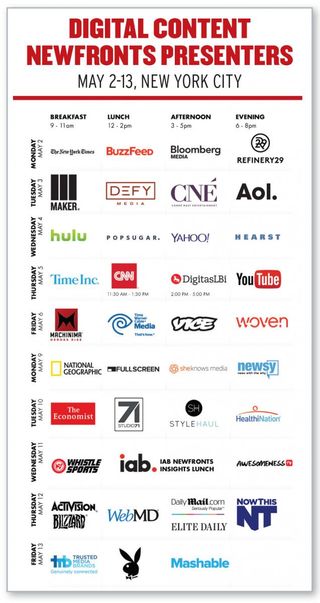Digital Video Market Surges Into NewFronts

Related: Buyers Downplay Strong Scatter on Eve of Upfront
As the major upfronts approach, broadcast and cable sales executives are talking about digital dollars coming back to TV.
You won’t hear that kind of talk at the NewFronts, where digital video companies big and small try to attract the attention of media buyers and advertisers. The annual jamboree is set for various New York venues May 2-13.
While a 3% to 5% gain would represent success in the TV advertising market, eMarketer forecasts that digital video ad revenue will be up 28.5% to $9.59 billion in 2016. The biggest part of that gain comes from mobile video, which is forecast to show a 47% gain to $4.08 billion, while desktop video grows 13.2% to $5.19 billion.
Media agency ZenithOptimedia, a division of Publicis, forecasts digital video spending to increase 18% in 2016 and 17% in 2017. The agency notes that there are concerns about digital video—starting with viewability, which affects the likelihood that a viewer will actually see the advertiser’s message.
“Unfortunately, ad viewability is just one of the many factors that have increased the complexity of online advertising. While ad viewability, cross-platform measurement, and non-human traffic concerns are not new to agencies and brands, ad-blocking issues have also emerged for online video,” the ZenithOptimedia report says. “We are already seeing new ad opportunities from online video partners who have developed new creative formats, such as embedded videos that live within related editorial content such as articles or slideshows and interactive choice-based video ads that offer consumer incentives.”
The issues with digital video appear to be a fairly small bump in the road to the NewFronts.
Broadcasting & Cable Newsletter
The smarter way to stay on top of broadcasting and cable industry. Sign up below
“We have as many clients attend NewFronts as upfronts,” says Dave Penski, CEO of Publicis Media Exchange. “So they’re very important to us.”
Nearly 40 companies will make New-Front presentations over two weeks. Some high-profile companies have pulled out of the NewFronts, either because they feel like they’ve outgrown the event like Crackle, or their digital video strategies have shifted, like Yahoo and Facebook.
The biggest company in digital video is You-Tube, one of the original NewFront partners.
”From our standpoint, the NewFronts remain a great time and place where a lot of buyers are concentrated on the market, so it’s a great time to connect with them,” says Tara Walpert Levy, managing director of agency solutions for YouTube.
Walpert Levy says YouTube is seeing more interest in negotiating upfront deals earlier than if the past, and that agencies seem to be looking to spend more.
“The online video ecosystem is exploding,” she says, with more attention being paid by both advertisers and viewers as watch time rose 50% year-over-year for three straight years.
Google’s Preferential Treatment
YouTube has been pushing Google Preferred, which puts advertisers into videos from the top YouTube creators only, ensuring that commercials will be adjacent to quality content and not homemade cat videos.
“From a reach standpoint, last year we talked about how in the core TV demos, adults18-34 and adults 18-49, we had more reach than any cable network,” Walpert Levy says. “And this year, incredibly, it’s actually more than any TV network, whether it’s broadcast or cable.”
And that’s just for mobile, not counting desktop. “Our strength in mobile continues to drive a lot of the growth, and yet YouTube viewing on the living room TV is actually up and going,” Walpert Levy says. “We’re having a dialog about reaching connected people from the handset to the TV set.”
Walpert Levy says the number of brands using Google Preferred has doubled year-to-year and that among top advertisers, spending on YouTube is up 40%.
That spending is having an impact. “We’ve been seeing an 80% increase in ad recall and a 17% percent increase in brand awareness for Google Preferred campaign,” she says.
Google has been offering real-time measurement for campaign metrics, such as favorability and purchase intent. That allows marketers to optimize campaigns as they run rather than getting feedback after the campaign is completed.
And while YouTube talks about reaching 18-49-year-olds as TV, it is able to offer more precise audience segments that advertisers want to spend against.
“We find it’s primarily our digital buyers who take advantage of custom segments and all of the different ways that you can cut audiences based on interests, based on content, based on activity, based on a number of things that digital is just fantastic for,” Walpert Levy says.
Hulu Makes Big Tent Bigger
Hulu, another NewFront tentpole, says its event will be bigger than ever.
The streaming video subscription service is moving to the Theatre at Madison Square Garden because the Hammerstein Ballroom has gotten too cozy, according to Peter Naylor, executive VP of ad sales.
Naylor says he likes the atmosphere of the NewFronts. “It’s a great opportunity to tell everybody what we’re up to and show the world we’re healthy and vital, thriving, investing, growing,” he says.
But Hulu calls its event the Hulu upfront. “I make that distinction because we’re more like TV than we are like anything else, and we absolutely transact in the TV marketplace,” says Naylor. “We’re NewFronts’ founding partner and love being part of the NewFronts; I just do that subtle language change because we look like television.”
Naylor says that the delineation between TV and digital video continues to evaporate and that the market is healthy. “We’re seeing a lot of year-over-year growth.
We’re seeing a lot of demand for what we do,” he says.
What Hulu does is the kind of long-form video that’s traditionally been on TV. “Quality is of course in the eye of the beholders, but considering that we’re now in bed with people like J.J. Abrams and Jason Katims, we were nominated for the Golden Globe this year, the quality is pretty unarguable,” Naylor says.
Subscribers have shifted how they view Hulu’s programming. Eight years ago when Hulu started, 100% of its viewing was done on desktop computers. Today, it’s 69% on the living room set through connected devices.
“It’s TV reinvented. Because it’s all through an IP address, I can target and serve up ads with data. I can do all the stuff that the digital guys do, and I can do it in the living room environment,” Naylor says.
Hulu will be making announcements about adding interactivity to the living room environment and some advancements in measuring streaming viewing in the living room.

Last year, Hulu announced an ad-free subscription plan. Not only has that not reduced ad revenue, but the subscribers who opt to see ads understand that advertising is making the lower monthly price possible. “Frankly the people who are consuming ad-supported Hulu because of that awareness, they become more valuable to the marketers. It hasn’t in any way shape or fashion slowed down our efforts in the ad sales group,” Naylor says.
Hulu also introduced a programmatic product. At this point, programmatic accounts for less than 10% of Hulu’s advertising volume, “but I see it only going in one direction,” Naylor says.
Print’s Pivot
For Condé Nast, best known for its magazines, the NewFronts are an opportunity to position its assets in a video marketplace, according to Lisa Valentino, chief revenue officer for Condé Nast Entertainment. As a legacy print entity, Condé has plenty of company in making its digital case to buyers, joining the The New York Times, Time Inc., Playboy and The Economist, among many others.
“We look at ourselves as a premium video network. Premium for us is really important. We invest heavily in telling great stories,” Valentino says. “With the consumer, there is a flight to quality. We see it every day in our numbers. There’s so much content out there.”
Much of Condé Nast’s video content can be found on its magazines’ sites, but also at a video hub dubbed TheScene.com, which was rolled out—where else?—at the NewFronts in 2014.
Condé Nast also sees itself as a next-generation studio, creating content for itself and partners.
“Most of the video content consumption is happening on mobile devices through social platforms these days,” Valentino says. “So we are there. We reach 138 million people socially through all of our brands. So those are pretty powerful pipes for us to be distributing video.” The pitch to advertisers is about quality video, upscale and influential viewers and scale.
“Premium content will always drive the higher end of the marketplace,” Valentino says. “With the market place conditions the way that they are, we’re setting up to have a very strong year.”
The branded content side of the business is exploding, she adds.
“This whole premise of I’d like the best storyteller in the world to tell my story if I’m an advertiser, that message is resonating,” says Valentino. “We have more work on the branded side than we’ve ever had before, so the dynamics of both having a growing premium studio and network and an active branded content business makes for a very busy year ahead.”
Jon has been business editor of Broadcasting+Cable since 2010. He focuses on revenue-generating activities, including advertising and distribution, as well as executive intrigue and merger and acquisition activity. Just about any story is fair game, if a dollar sign can make its way into the article. Before B+C, Jon covered the industry for TVWeek, Cable World, Electronic Media, Advertising Age and The New York Post. A native New Yorker, Jon is hiding in plain sight in the suburbs of Chicago.

